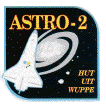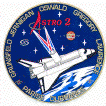|
|||||||||||||||||||
|
|
|||||||||||||||||||
|
|
Achievements of Astro-2
HUT scientists developed more than a dozen distinctly different scientific goals to be pursued on the Astro-2 mission. The addition of seven Guest Investigator teams brought the total list of programs to more than 20. Many of these were new programs that took advantage of HUT's increased sensitivity and the longer mission duration. Others represent further detailed investigation of topics begun with Astro-1 observations. Many of the results from Astro-2 are still being analyzed, but a handful of the early results are summarized below.
For a more in-depth look at the various programs, you can link to the HUT Science Program Overview for Astro-2. This document (with subsequent links) was written prior to Astro-2, and provides a wealth of information on the scientific goals for each program. You can also read the abstracts (and in some cases the entire technical papers) on-line by clicking here.
Early Results from Astro-2
THE INTERGALACTIC MEDIUM -- The HUT science team's highest priority science goal was to detect and measure the characteristics of the primordial intergalactic medium (IGM), a hypothesized gas thought to be spread throughout the Universe between the galaxies. The observation required involved multiple observations of a faint, high redshift quasar, using it as a "background" source to shine through the IGM; absorption of the quasars light at the "right" ultraviolet "colors" would indicate the presence of this elusive component of the Universe. To make a long story short, WE DID IT! But the explanation is impossible to summarize in this overview format. Click here for a more detailed discussion of this exciting result!
ACTIVE GALAXY NUCLEI -- HUT was used to observe the active galaxy NGC 4151, which may harbor an obscured black hole in its nucleus. The object was known to be variable on weeks-to-months timescales, and it had also been observed during Astro-1, providing an important comparison. Nature cooperated: NGC 4151 was observed to be some five times brighter during Astro-2 than it was during Astro-1! A detailed comparison of the differences is allowing an unprecedented view of the structure of the region in close to the black hole. Time variability over periods as small as two days may also be present in the Astro-2 data.
ELLIPTICAL GALAXIES -- During Astro-1, only one elliptical galaxy and one "galactic bulge" region of a spiral galaxy (thought to be similar to an elliptical galaxy in many regards) were observed sufficiently well to constrain models of the stars producing the faint UV light in these galaxies, and even this provided breakthroughs in our understanding. An initial HUT paper on this topic reports first results for SIX elliptical galaxies from Astro-2, which are used to confirm and extend the preliminary Astro-1 results.
SUPERNOVA REMNANTS -- These are the expanding gaseous nebulae created by supernova explosions, which often remain visible for tens of thousands of years. As these nebulae expand, they heat normally invisible regions of interstellar gas and cause them to glow. Hence, they provide new information not only about the stars that exploded but about the interstellar medium. Very few of these objects, however, are observable in ultraviolet light because of intervening absorption by dust and gas in the plane of our galaxy.
Early Astro-2 results have already reported new detections for two galactic supernova remnants. The remnant called "Puppis A" was detected throughout the HUT wavelength range, producing insight into a cosmic collision between the supernova blast wave and an interstellar cloud. Also, HUT was used to detect emission from a young remnant called SN 1006, so called because the supernova was observed by Chinese astronomers in 1006 A.D. This is a "young" supernova remnant and the HUT detection is the first UV observation of such a fast interstellar shock wave, estimated to be traveling at 3000 kilometers per second (close to 1900 miles per second!). Many other observations in this category are expected to provide new results as analysis continues.
THE HOTTEST STARS -- Massive young stars and old, highly evolved low-mass stars are both much hotter than the majority of stars and consequently emit strongly at the far-UV wavelengths that can be studied with HUT. Several of the hottest young stars in in the nearby galaxies called the Magellanic Clouds were observed in order to determine their temperatures, masses and radii. In addition, HUT provides unique information on the "stellar winds" from these most massive of stars. Included in these observations was the current candidate for the most massive single star, at nearly 200 times the mass of our sun!
CATACLYSMIC VARIABLE STARS -- Certain cataclysmic variables undergo occasional outbursts in which their brightness increases by factors of 100 or more. The time between outbursts is not regular, but varies from two weeks to months or longer. The cause of these outbursts and their affects on the stars is poorly understood. On Astro-2, HUT scientists observed the dwarf nova U Geminorum 185 days after an outburst, which is the furthest away from outburst that the system has ever been observed. During Astro-1, HUT had observed this binary star just 10 days after an outburst. The comparison is very interesting, showing the clearest evidence yet that the white dwarf star not only gets heated during an outburst, but that this heating primarily affects only a portion of the white dwarf's surface. Many other cataclysmic variable observations are still being analyzed.
Mother nature also cooperated by supplying three bright novae in the month or so prior to the Astro-2 launch. These objects were still in their decline phase during the mission, and HUT observations of two objects have been reported, including a time sequence on one object. The HUT observations were used to determine the abundances of carbon, nitrogen, and oxygen in the expanding gaseous shells as well as the time variability of the emissions.
SYMBIOTIC STARS -- These objects are composed of two stars in the late stages of evolution orbiting each other at a distance similar to that of the Earth from the Sun. One star is a hot white dwarf which irradiates its cooler red giant companion. Astronomers made far-ultraviolet observations of several symbiotic stars with both HUT and WUPPE. They are studying the effect of the hot star's intense ultraviolet radiation on the outer layers and stellar wind of the red giant star. This is providing a unique perspective on the structure and evolution of red giant star atmospheres.
SOLAR SYSTEM -- HUT scientists observed the Jovian system (Jupiter and its moons) for comparison with Astro-1 observations. This comparison will permit a better understanding of the importance of the changing solar input. (Astro-2 was near solar minimum, while Astro-1 was near solar maximum.) A coordinated observation of Jupiter's northern polar aurora between HUT and the Hubble Space Telescope will provide unique information on the physical processes and excitation mechanisms in the giant planet's atmosphere and magnetosphere.
HUT was also used to observe Venus and Mars. The atmospheres of these planets, although very different from one another in terms of density, are both dominated by carbon monoxide emissions. Comparison of the HUT observations will provide new insights into the atmospheres of our nearest planetary neighbors.


|
|
|




 Follow Us
Follow Us